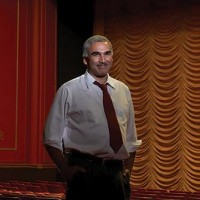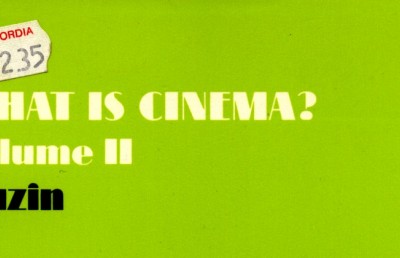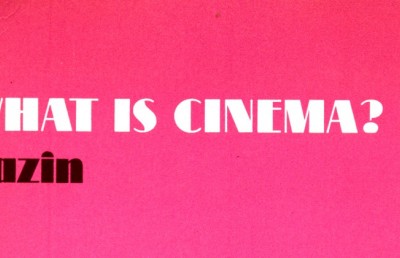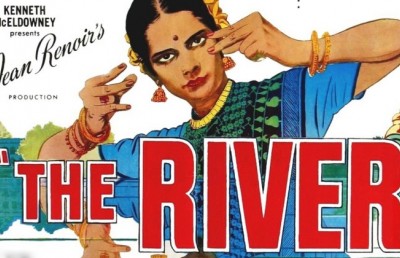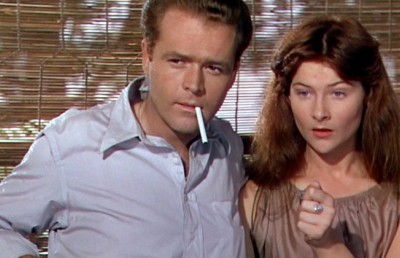Re-reading Bazin’s Ontological Argument
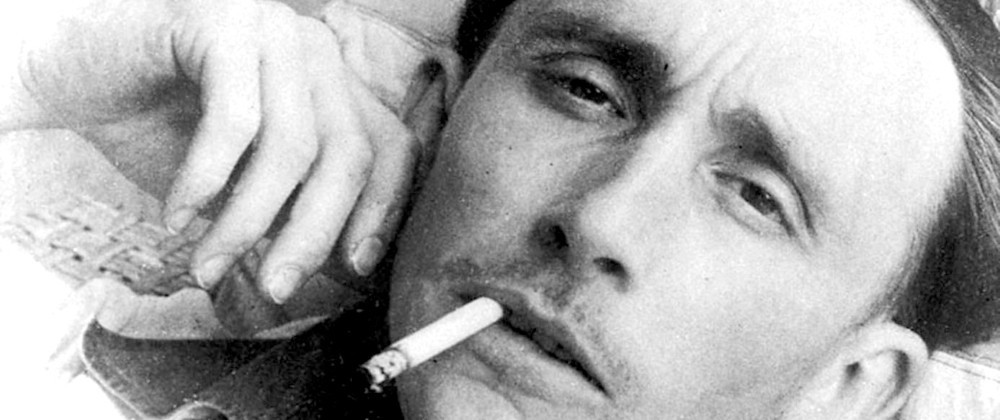
Introduction
I would like to begin by outlining a problem that I hope will resonate with your own experiences of reading Bazin. This problem emerges as soon as one abandons the conventional distinction between Bazin the Theorist and Bazin the Critic, that is, the tacit hierarchy that divides his work into a “theoretical core” based in the first three essays of What is Cinema? and a little-explored “periphery” containing the great bulk of his writings. Even if one confines one’s exploration to the portion of this periphery readily available in English translation, one soon discovers a figure whose historically-sensitive contributions to the field cannot be reconciled with the abstract theoretical doctrines that are generally-attributed to him.
There is the Bazin of “The Evolution of the Western” and “On the politique des auteurs”, whose consideration of the genre film and “the genius of the [classical Hollywood studio] system” stands at the origin of the examination of that system in the work of Bordwell, Thompson and Staiger, Schatz, Maltby and others. There is the Bazin of “The Death of Humphrey Bogart” and “Entomology of the Pin-Up Girl”, whose analyses of star images, eroticism and other modes of myth and Attraction preceded Roland Barthes’s Mythologies by more than a decade, and Richard Dyer’s Stars by more than three decades. Finally there is the Bazin of “Adaptation, or the Cinema as Digest” and “The Cinema and Popular Art”, who critiqued notions of the work and authorship and affirmed the political potentials of the cinema, its Benjaminian implications, long before these topics became common currency. There are of course many other aspects of Bazin’s work, but these three have perhaps suffered most from the neglect imposed by the core-periphery schema. Against the backdrop of contradiction internal to this schema, I aim to offer a reading of “The Ontology of the Photographic Image” capable of reconciling its argument with the totality of Bazin’s work.
The central task of my reading is to recover the crucial but generally-neglected distinction outlined in the following quote:
The quarrel over realism in art stems from a misunderstanding, from a confusion between the aesthetic and the psychological; between true realism, the need that is to give significant expression to the world both concretely and in its essence and the pseudorealism of a deception aimed at fooling the eye (or for that matter the mind); a pseudorealism content in other words with illusory appearances (WCI, 12).
Bazin here identifies “two essentially different phenomena that any objective critic must view separately in order to understand the evolution of the pictorial” (WCI, 11). This distinction between the aesthetic and the psychological is crucial to understanding Bazin’s use of the term reality which is here explicitly connected to art and the aesthetic. Though the full sense of this connection has yet to be unpacked, as stated it allows me to preview the basic point at which my account will diverge from the standard views of the ontological argument. Despite their differences, all of Bazin’s most prominent interpreters – from his biographer Dudley Andrew to his would-be nemesis Noël Carroll – read his argument as claiming that the photograph has, as such and without regard to its aesthetic qualities, a privileged relation to pro-filmic reality that film-makers are prescribed to maintain. As Andrew puts it:
For Bazin the situation was clear: either a filmmaker utilizes empirical reality for his personal ends or else he explores empirical reality for its own sake. In the former case the filmmaker is making of empirical reality a series of signs which point to or create an aesthetic or rhetorical truth, perhaps lofty and noble, perhaps prosaic and debased. In the latter case, however, the filmmaker brings us closer to the events filmed by seeking the significance of a scene somewhere within the unadorned tracings it left on the celluloid (MFT, 145).
In a moment we will reconsider some of the textual evidence often produced in support of this position. My immediate concern is simply to observe that nowhere does Bazin argue for the exceptional status of photographic art vis-à-vis the aesthetic/psychological distinction and that, in fact, he deliberately structures the entire Ontology essay around this distinction. Though this feature is not reproduced in Hugh Gray’s translation, Bazin organized the essay into six distinct sections separated by asterixes. Consideration of this structure reveals that he establishes the distinction in the first section of the essay, explores the psychological genealogy of photography in the second, third and fourth sections, examines the aesthetic potentials of photography in the fifth section, and concludes with the famous reversal of the sixth and last section: “On the other hand, the cinema is a language” (my translation) (“D’autre part le cinéma est un langage”). In a loose accord with this structure my own comments will deal first with psychology, next with aesthetics, and will conclude with an examination of the reversal and its implications.
I. Psychology
As you all know, the first section of the essay traces the psychological function of art from ancient Egypt up to the present, and closes with the following conclusion:
If the history of the plastic arts is not only a matter of their aesthetic but in the first place a matter of their psychology, it is essentially the story of resemblance, or if you will, of realism (my translation) (QCI, 12).
For our purposes it is essential to note that Bazin reaches this conclusion after acknowledging that “the evolution, side by side, of art and civilization, has relieved the plastic arts of their magic role” (WCI, 10). Without denying the processes of desacralization, rationalization and historical understanding that have characterized the development of modern culture, he nonetheless affirms the inescapable role of resemblance in any culture, bluntly asserting that the power of suggestibility we associate with the “primitive” ideologies of the past remains at work in the midst of contemporary illusions of radical human autonomy:
Civilization, cannot, however, entirely cast out the bogy of time. It can only sublimate our concern with it to the level of rational thinking. No one believes any longer in the ontological identity of model and image, but all are agreed that the image helps us to remember the subject and to preserve him from a second spiritual death. Today the making of images no longer shares an anthropocentric, utilitarian purpose. It is no longer a question of survival after death, but of a larger concept, the creation of an ideal world in the likeness of the real, with its own temporal destiny. “How vain a thing is painting” if underneath our absurd admiration for all its works we do not discern man’s primitive need to have the last word in the argument with death by means of the form that endures (WCI, 10) (the quoted portion of this last sentence is from one of Pascal’s pensées).
In order to take a full measure of its rhetorical force and intent, I will restate what Bazin is affirming here in a series of polemical propositions:
1. Whether they acknowledge it or not, human beings are attached to mortal things by an erotic or ethical relation.
2. The development of human rationality notwithstanding, this attachment always takes the form of an irrational attraction to the appearances of those things.
3. Its stated motives and historical justifications notwithstanding, all art derives its motive force from this irrational attachment to appearances.
It is essential to emphasize the skeptical aspect of Bazin’s affirmations about psychology, his manifest awareness of human vulnerability to illusion and ideology. For Bazin, our receptivity to the world in which we live is inevitably conditioned by the desire we carry with us and the ideologies that have shaped that desire. This vulnerability is presented as an inescapable constant relevant to the consideration of all art including photography and the cinema. Though Bazin’s interpreters are correct in recognizing his affirmation of the photograph’s relation with Appearance, they mistake his emphasis on the power of Appearance over human credulousness for some form of naive faith. Instead, this emphasis should be seen to reflect a skepticism far more radical than that of any of his critics, for to Bazin the photograph is in the first instance a powerful and ambiguous illusion that defies the critical power of the modern rationality that created it:
… the essential factor in the transition from the baroque to photography is not the perfecting of a physical process […]; rather does it lie in a psychological fact, to wit, in completely satisfying our appetite for illusion by a mechanical reproduction in the making of which man plays no part. […] This production by automatic means has radically affected our psychology of the image. The objective nature of photography confers on it a quality of credibility absent from all other picture-making. In spite of any objections our critical spirit may offer, we are forced to accept as real the existence of the object reproduced, actually re-presented, set before us, that is to say, in time and space. […] A very faithful drawing may actually tell us more about the model, but despite the promptings of our critical intelligence it will never have the irrational power of the photograph to bear away our faith (my italics)(WCI, 12-14).
In these quotes and many others we might consider, Bazin’s point is to recapitulate with regard to the photograph the general argument about the psychological basis of art that he made in the essay’s first section, i.e. the discussion of the photograph elaborates his general point that the irrational power of resemblance persists within the domain of our enlightened and modern civilization. Far from disclosing a pseudo-scientific or mystical “axiom of objectivity”, Bazin’s argument in the first four sections of the essay works from the assumption that theory alone is as powerless to discriminate between truth and illusion in the photograph as it is in everyday life.
II. Aesthetics
Thus though it may satisfy our appetite for illusion the photograph does not, in itself, satisfy our appetite for reality. In Bazin’s theory only art can do this, though, as we have already noted, the reality of art paradoxically depends on the more primary psychological fact of illusion. To understand this paradox we need to retrace its articulation in the essay’s first section. The section closes with the adaptation of a quote from Pascal, the original of which reads: “How vain is painting, which attracts admiration by the resemblance of things, the originals of which we do not admire!” (PP, 38). This polemical reference serves to return us to the point earlier in the section where Bazin defines the paradoxical function of art as “sauver l’être par l’apparence” or “to save Being by means of Appearances” (QCI, 12). If the task of art is to fundamentally satisfy our erotic or ethical attachment to the mortal beings that inhabit our world, the quote from Pascal underlines the ambiguous value of resemblance in allowing us to accomplish this task. For Pascal this ambiguity is an inescapable fact of the human imagination and like Bazin he recognizes the extent to which it defies rationality. As he puts it in another pensée:
It is that deceitful part in man, that mistress of error and falsity, the more deceptive that she is not always so; for she would be an infallible rule of truth, if she were and infallible rule of falsehood. But being most generally false, she gives no sign of her nature, impressing the same character on the true and the false. I do not speak of fools, I speak of the wisest men; it is among them that the imagination has the greatest gift of persuasion. Reason protests in vain; it cannot set a true value on things (PP, 24).
Recasting this ambiguity in terms of the aesthetic/psychological distinction, we might say that the psychological power of resemblance leads us equivocally to imaginative relations with both truth and illusion, and that the aesthetic is that faculty which allows us to discriminate between these relations. But when viewed in the context of their common root in desire and the inability of reason to discriminate between them, Bazin’s repeated distinction between the aesthetic and the psychological forces us to track it into another dimension: we are led to posit a qualitative difference in the heart of desire that distinguishes aesthetic achievement from illusion.
This difference is only articulated later in the essay, in the quote with which we began. Unpacking the full sense of this quote, we find that it distinguishes between a basic psychological desire that is “content with illusory appearances” and a higher or stronger form of desire that is only satisfied with true realism, defined here as a union of “the Concrete” and “the Essential”. Seen as the process of discriminating between true and illusionary relations, Bazin’s model of aesthetic activity presupposes a simultaneous double-mimesis that puts the sensual power of Appearances to work in the service of an invisible reality that only a higher quality of desire allows access to. It is this process of double-mimesis that is expressed in the phrase “the form that endures” (la pérennité de la forme) which refers at the same time to the persistence of resemblance itself, the formal qualities of art, and the Platonic notion of forms. The form of the work of art thus fuses together two realms, a realm of sensuous immediacy grounded in the power of resemblance, and a realm of Necessity grounded in Being or Truth. With this general model in mind, Bazin’s affirmations concerning the aesthetic potentials of photography lose their hyperbolic character, for one is able to recognize in them the theoretically-indistinguishable coincidence of the irrational power of conviction inherent to the photographic medium with the process of ethical orientation and ideological discrimination proper to any art. Thus:
Only the impassive lens, stripping its object of all those ways of seeing it, those piled-up pre-conceptions, that spiritual dust and grime with which my eyes have covered it, is able to present it in all its virginal purity to my attention and consequently to my love. By the power of photography, the natural image of a world that we neither know nor can see, nature at last does more than imitate art: she imitates the artist (my italics) (WCI, 15).
At the root of Bazin’s ontological argument one can discern the assumption of an inescapable ethical dimension to human life and culture, one which simultaneously secures the illuminations of art and the skeptical awareness of ideology. This assumption and process of discrimination can be discerned at work throughout Bazin’s writings, as in the following passage from “An Aesthetic of Reality” which serves to illustrate all the main points we have considered so far:
Reality is not to be taken quantitatively. The same event, the same object, can be represented in various ways. Each representation discards or retains various of the qualities that permit us to recognize the object on the screen. Each introduces, for didactic or aesthetic reasons, abstractions that operate more or less corrosively and thus do not permit the original to subsist in its entirety. At the conclusion of this inevitable and necessary “chemical” action, for the initial reality there has been substituted an illusion of reality composed of a complex of abstraction (black and white, plane surface), of conventions (the rules of montage, for example), and of authentic reality. It is a necessary illusion but it quickly induces a loss of awareness of the reality itself, which becomes identified in the mind of the spectator with its cinematographic reproduction. As for the film maker, the moment he has secured this unwitting complicity of the public, he is increasingly tempted to ignore reality. From habit and laziness he reaches the point when he himself is no longer able to tell where lies begin or end. There could never be any question of calling him a liar because his art consists in lying. He is just no longer in control of his art. He is its dupe, and hence he is held back from any further conquest of reality.
III. Language
“On the other hand, cinema is a language.” This famous Janus-faced sentence functions as a crucial mediator between the ontological argument and the remainder of the essays in the four volumes of Qu’est-ce que le Cinema?. It serves to remind the reader that the process of spiritual struggle I have just sketched out takes place not in some ideal realm but in the historically-conditioned languages and cultures from which the art of the cinema emerges. In a prospective sense it indicates that in the essays that follow the aesthetic achievements of the cinema will only be registered by attending to the historical changes they effect in cinematic language. In a retrospective sense, its blunt qualification of what preceded it reminds us of the dangerous potential for misunderstanding such poetic affirmations, which are in fact nothing more than a set of inferences about cinematic potential drawn from the realized facts of cinematic art. In this context the debates between Bazin’s supporters and detractors about the nature of the reality he is referring to misses the point, for the reality revealed by art is the source of all definition or difference and cannot itself be defined; though they have undoubtedly been the cause of much confusion, words such as “realism” and “reality” are in effect only the vanishing points at which Bazin’s critical discourse loses the ability to distinguish truth and illusion in any given instance of cinematic art.
Considered against this retrospective note of caution, my own elaboration of the ethical vocation of art was itself reckless insofar as it reduced Bazin’s criticism to a Platonic or Levinasian reading of it; it is important to emphasize that one could also characterize the process of double-mimesis in terms of Benjamin’s dialectical history, or in the language of Bordwell’s Historical Poetics, Barthesian semiotics or Deleuzian philosophy. What is unique about Bazin’s approach is that the rigor of his skepticism prevents him from subordinating the experience of art to any one of these theoretical frameworks. If specific conjunctures of language, circumstance and illusion form the only discursive crucible in which aesthetic achievement dialectically distinguishes itself from a historical baseline of ideology, if art is the only form of discourse that actually makes a historical difference, then the prime responsibility of the critic is to use analysis and inference to reconstruct the contexts of film history that makes these interventions possible, not to arrogate to itself the theoretical ability to distinguish art from ideology. On its own terms, Bazin’s rigorous subordination of theory to the nomadic itinerary of aesthetic experience can claim to have made a stronger intervention in cultural history than the modes of ideological critique that succeeded it; from his perspective, contemporary approaches that deploy theoretical models of ideological operations are themselves entangled in an unwitting complicity that neutralizes real difference while manufacturing its ersatz. Thus among other things a re-appraisal of Bazin’s ontological argument may provide us with motives to re-consider our discipline’s history and self-understanding.
BIBLIOGRAPHY
Andrew, Dudley. The Major Film Theories (New York: Oxford UP, 1976)
Bazin, André. What is Cinema? Vol.II, 26
Bazin, André. What is Cinema? Vol. I, ed. Hugh Gray (Berkeley, CA: UC Press, 1967).
Bazin, André Bazin. What is Cinema? Vol.II, ed. Hugh Gray (Berkeley, CA: UC Press, 1971)

